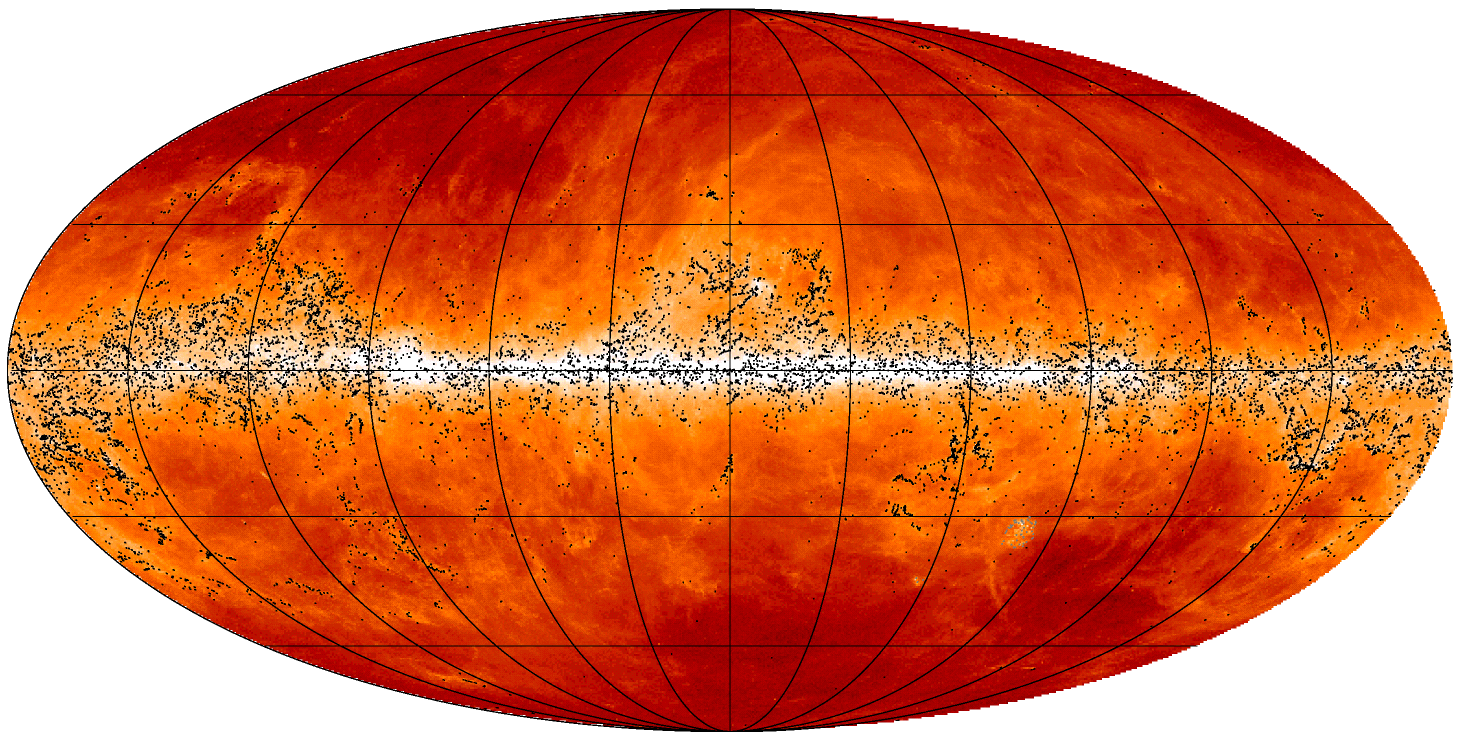Orsolya Fehér
NOEMA Science Operations Group
Institut de Radioastronomie Millimétrique (IRAM), Grenoble, France
Interstellar Material and Early star formation on different spatial scales
RESEARCH interests
1. physics and star formation in cold, dense galactic "clumps" and cores
- relying on Planck and Herschel detections (PGCC objects)
- physical parameters, kinematics, and stability of possible star-forming sites from dust continuum and molecular line emission
- correlations with galactic position, cloud morphology, environment, ongoing SF...
- to connect the governing processes of SF with observed environments and features, identify sites of very early star formation
Galactic Cold Cores research team (Herschel Key Programme, PIs: Mika Juvela, Isabelle Ristorcelli, supervisor: L. Viktor Toth)
TOP-SCOPE project (PI: Tie Liu)
INitial conditions of star formation

Planck: > 13,000 dense, cold, potentially star forming galactic structures ("clumps")
--> a possibility to study of the earliest phases of SF on a statistical sample
nature of the objects, initial conditions, stages, timescales, environmental effects
Herschel: high resolution and sensitivity FIR maps of individual regions
credit: L. Montier
the STructure of the Tmc-1 filament
- dense, filamentary cloud in Taurus
- part of a bush-like group of Planck objects (Heiles Cloud 2) with complex morphology (ring?)
- high S/N and velocity resolution NH3 observations with the Effelsberg telescope as part of our survey of cold dense regions spanning several years

Fehér et al. 2016, A&A
- temperature and column density distribution + kinematics --> sub-structures
- close to equilibrium, chemical and dynamical age different in N and S subfilaments
- turbulence increased by an outflow of a nearby YSO reaching the main ridge
CO survey of Planck objects
- part of a systematic ground-based molecular emission survey of Planck objects
- correlation of continuum- and line-based densities, temperatures, determination of stability
- 35 clumps observed with two CO isotopologues with the Onsala 20m telescope

- most objects are cold, dense, rare traces of heating
- continuum- and line-based densities correlate well
- kinematic distances, stability estimates
- 2 object groups: close-by, core-sized, low-mass and gravitationally unbound clumps and massive, parsec-scale clouds farther away

Fehér et al. 2016, A&A
NH3 survey of planck objects in various environments
- part of the TOP-SCOPE collaboration measuring sub-mm continuum and many gas tracers towards/close to samples of Planck objects
- 100 dense clouds in varying environments (high-latitude, filamentary, in clusters close to the GP)
- pointed NH3 inversion transition measurements with the Effelsberg telescope (+ water maser)
- global and by-environment statistics of temperatures, densities, turbulence...
- dependence on galactic position, distance, protostellar/starless
Fehér et al. 2022, ApJSS

for the future: AMmonia surveys of the galactic cold ISM
- Effelsberg observations 2008-2016
-
~ 40 PGCC mapped NH3(1,1) and (2,2) transitions
(Tóth, ..., Fehér, ..., in prep) - connecting to galactic environment and ongoing SF
-
individual objects studies:
- the double core of G163.82-8.44
(Zahorecz, ..., Fehér, ..., in prep.) -
the clumps of Heiles Cloud 2
(Fehér et al. in prep)
- the double core of G163.82-8.44

Research interests
2. circumstellar material of young stellar sources
- FU Orionis-type, low-mass, eruptive young stars
- millimeter radiointerferometric maps of the continuum and a number of molecular species/transitions with ALMA, NOEMA, JCMT, APEX
- tracing the envelope, the envelope/disk interface, the disk (distance!)
- morphology, kinematics, mass transfer...
- only a couple dozen of these objects but might answer interesting questions wrt: luminosity problem, universality of episodic accretion in low-mass SF, accretion processes
Momentum Disk Research Group (PI: Ágnes Kóspál) + SACCRED ERC project (PI: Ágnes Kóspál)
Interferometric view of the envelopes of Fu ori-type stars
- IRAM/NOEMA interferometric observations of northern FUors (CO and 2.7 mm continuum)
- size, mass, kinematics of envelope
- 14 objects to this date

- detection of "extended envelopes" on a 10,000 AU scale, clumpy structure
- heated, few 1000 AU envelopes centered on the stars, outflows
- envelope parameters suggest Class I and II sources - "normal" YSOs in a special state? evolutionary sequence?
- joint ALMA survey: more complicated picture
Fehér et al. 2017, A&A

Ábrahám, ..., Fehér, ..., 2017, ApJ
Kóspál, ..., Fehér, ..., 2021, ApJSS
MASS Transport around V346 Nor
- pilot study for our ALMA project on southern FU Ori-type objects
- CO isotopologues and 1.3 mm continuum with a resolution of ~1" (~700 AU)
- disk/envelope/outflow cavity mapping, mass, kinematics, morphology

- compact continuum, extended CO emission
- spectro-astrometry: outer pseudo-disk (rotation + infall), inner 350 AU keplerian disk
- the infall rate from the envelope to the disk is a factor of a few higher than the quiescent accretion rate --> mechanism of eruption
Kóspál, ... Fehér, ..., 2017, ApJ

FOR the future: joint study with ALMA, chemistry, and more
-
ALMA study of > 10 FU Orionis-type objects
- CO and continuum mapping to derive physical parameters, see structure and kinematics
-
chemical study of FUors with single-dish measurements
- IRAM, APEX
-
resolving the envelope/disk interface with NOEMA
- might reach spatial resolutions close to ALMA
- dynamics of infall
- monitoring new FUor detections --> increasing the sample to disentangle the role of these objects and processes
skills acquired during my research
- observation and data reduction/analysis experience using several radio telescopes (Effelsberg, Onsala, IRAM, JCMT)
- experience with planning/scheduling/reducing a diverse sample of scientific projects & a good view of the "everyday problems and challenges of telescope systems" as astronomer-on-duty at NOEMA
- utilisation of the GILDAS software package (CLASS, CLIC, MAPPING) for radiospectrostcopic data calibration, reduction, and analysis
- frequent usage of IDL, python, ds9
- writing and planning telescope proposals as PI and co-I (Effelsberg, IRAM 30m/NOEMA, APEX, ALMA)
- teaching and tutoring (observational astronomy to BSc students, supervision of summer projects and thesis work of MSc students)
- organizing and participating at several workshops, scientific "Coffee Breaks"
- presenting at conferences (Herschel workshops, IAU, EWASS)
Cardiff University interview presentation
By Orsolya Fehér
Cardiff University interview presentation
- 337



